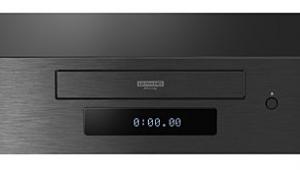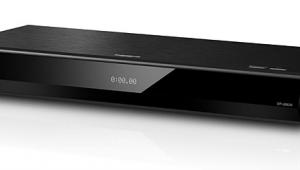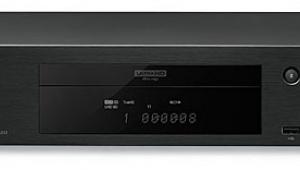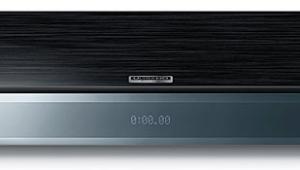Pioneer Elite BDP-HD1 Blu-ray Disc Player: Short Take

Sure, the companies involved in the format war are trying to garner as much profit for themselves in as many ways as they can, and why shouldn't they, in a capitalist world economy? The fact is that I love movies. And my favorite movies have never looked as good at home as they look in HD on either of these new formats. Hell, some of them might not have looked this good in a theater!
As much as these companies want to sell their formats and their libraries, I want to buy them again and guarantee one (or both) of them success so I can keep getting my fix of HD movies. These formats can both look and sound better than any broadcast format currently can, and it's likely to be a long time before we'll have the kind of bandwidth into our homes that would allow downloads to offer a shadow of the quality Blu-ray and HD DVD deliver. Guessing what the mass-market will do is difficult for someone who's quality conscious like myself; but it's clear to me that these formats are the enthusiast's choice.
And that, at long last brings me to the Pioneer Elite BDP-HD1 Blu-ray Disc player. Like the Elite Laserdisc players of yore, this is an enthusiast product aimed at an enthusiast market. Yes, the $1,500 this player costs is less than the Elite CLD-79 Laserdisc player I bought over a decade ago. But in a day when progressive scan DVD players can be bought for $40, it's an upscale product in relative terms at least.
Let's add that we're looking for a hero. Blu-ray stumbled out of the gate with a Samsung player and software that performed poorly enough to make many of us question the validity of the format. Recently released players and BD transfers have convinced us of the format's potential for killer app quality picture and sound, but we're still waiting for a player to stand above the rest. So far, the Pioneer Elite BDP-HD1 looks to me to be that player. I've spent a few days with it now, and here's my Short Take on where it stacks up.
To make something of an understatement, there is far more in common than not between this player and Sony's BDP-S1, including the computer-grade BD drive mechanism (made by Pioneer), the on-screen menus and much functionality. Regarding these similarities Pioneer would only confirm that it unequivocally performed its own R&D for this player and that it manufactures its own player. Period.
Looks-wise, the players couldn't be much different as far as the faceplates go. The Sony player is flashier, with its silver top cover and the blue facia that covers half the front panel. The BDP-HD1 is classic gloss black, and handsome in an understated way.
So, let me touch on some of the similarities (and peculiarities) of functionality between the two. Perfect sound forever? The computer BD drive does play DVDs, but does not allow playback of CDs. There is an HDMI output, but not the vaunted HDMI 1.3.
The BDP-HD1 is not compatible with either Dolby TrueHD lossless or DTS-HD Master Audio lossless, other than the ability to playback the "core streams" for each, which are compatible with existing lossy Dolby Digital and DTS decoders at 640kbps and 1.5Mbps, respectively.
Is this a death knell? Hardly. The BDP-HD1 is firmware upgradeable, so it's not at all out of the question to think an upgrade will allow decoding of TrueHD or DTS-HD Master Audio, or both. Once an update happens, the player would then decode TrueHD and DTS-HD Master Audio for output over the analog multichannels outputs, or transcode the lossless steams to PCM, which can go over the HDMI output.
All that HDMI 1.3 would add is the ability to carry the new lossless streams in their native, digital form. This, in turn, would require that the AV receiver or pre-pro be capable of internally decoding these formats. To our knowledge there are not any current AVRs or pre/pros on the market that are HDMI 1.3 compatible, but many current models (but not all) will accept and play back multichannel PCM over HDMI.
It's also worth noting too that the analog multichannel outs on the BDP-S1 are 5.1-channels, not 7.1. Whether anyone needs this or not is up for debate, but there will be 7.1-channel material in the marketplace at some point.
The BDP-HD1will output 1080p/24 from Blu-ray Discs, and is also an upconverting player capable of scaling standard DVDs all the way up to 1080p over HDMI. The output resolution can be chosen on the fly from the remote. Another nice touch is that, like the Sony BDP-S1, the Pioneer allows an "Auto" setting of the HDMI audio output, which outputs the audio stream over HDMI in its native format, with no transcoding. Uncompressed PCM remains as such, but neither DTS or Dolby Digital are converted to linear PCM when those tracks are selected from a disc.
A big difference between the Sony BDP-S1 and this Pioneer Elite is the inclusion of an Ethernet port, and Pioneer has thrown in some other enhanced functionality surrounding it. The Ethernet connectivity will allow system updates to be completed easily and at some point may be used for enhanced interactivity on Blu-ray Disc titles. On top of that, it allows Pioneer's Home Media Gallery feature to stream music, photos and videos from PCs on your home network to the BDP-HD1, and thus into your home theater. Supported file formats include a broad variety of popular music formats, as well as standard and high-definition video files. But, the catch is, according to the user manual, that the files must be stored on a Windows XP computer with Windows Media Connect and a DLNA-compatible media server. I'm a Mac guy who'll never (re)join the Dark Side, so you're not going to learn about this feature from me!
As with the BDP-S1, the startup time on this player is long, clocking in at around 45 seconds from power up to the Pioneer logo appearing on screen. However, thanks to a tip from Pioneer's Chris Walker, after I connected the BDP-HD1 to my home network via the Ethernet port that shaved off around 10 seconds, with the player consistently booting up in about 35 seconds. Like the Sony, it takes the BDP-HD1 35-40 seconds to load a 50GB Blu-ray Disc to its first menu. Faster than the first-gen Toshiba HD DVD players to be sure, but a mile behind the PS3, which is the champ with a sub-10 second load time.
The BDP-HD1 is not quite as sluggish as the Sony BDP-S1 with scanning backward, forward, and changing scan speeds, but again it's no PS3 in that regard either. And it too has the odd habit of occasionally pausing on a frame or two during scans.
So far, I've used the BDP-HD1 via its HDMI output only, with Sony's Pearl projector, which is a three-chip, 1080p SXRD. I used it on my 80" wide Stewart Studiotek 130, a white, 1.3-gain screen. I compared its picture directly to Sony's BDP-S1 and the PlayStation3.
Once the movies started spinning at 1080p/24, I saw the same outstanding image quality I'd seen with the Sony standalone player. With the best transfers on any video codec the picture was crystal clear, sharp and three-dimensional. The Pioneer and Sony players reproduce fine, small detail in a superior fashion and this also pays dividends with overall depth of image, which is just stunning with the best BD transfers. Also, the more obvious grain structure present in many MPEG-2 and AVC transfers was rendered with all the fine delicacy required to add the experience, not detract from it.
An interesting comparison is looking at VC-1 encodes on discs that are available on both Blu-ray and HD DVD. With the firmware updated Samsung player and the PS3 running the BDs of Blazing Saddles and Phantom of the Opera I'd previously seen a slightly sharper image from the HD DVDs via 1080i from the Toshiba HD-XA1. Not anymore. As with the Sony BDP-S2, the Pioneer Elite shattered this slight mismatch with their output set to 1080p/24. And interestingly, my impressions is still that the 1080p/24 output from the BDP-HD1 looks slightly sharper than the 1080p/60 output of the same player.
There isn't any doubt in my mind now that both the Sony BDP-S1 and the Pioneer Elite offer a superior image to the PS3, which is no criticism of the game console at all. These players are just that good; crisp and clear, but completely natural and non-fatiguing. And on a big screen the extra level of dimensionality is nothing short of astonishing.
The BDP-HD1 is also an outstanding upconverting DVD player, and it and the Sony BDP-S1 stand alone in that regard when compared to the PS3 or the Samsung BD-P1000. The image is crisp and detailed, but very natural with as much depth as the now legacy format will allow. It looks best at 720p or higher.
One interesting note is that neither the Sony BDP-S1 nor the Pioneer Elite handle beat up DVDs very well. I usually take good enough care of my DVDs for this not to matter, but now that I have a 21-month old my Pixar movies are taking a beating. A couple of these discs locked up the BDP-HD1 and the Sony standalone player, and I wouldn't make much of it except in both cases I put the same disc into the Toshiba HD-XA1 and they played back fine.
The BDP-HD1 carries a 50% price premium over the Sony BDP-S1, but in my opinion it's worth your consideration. For me, it makes a big difference having an Ethernet port and having the potential to download software updates as they become available and at least having a chance that the player will work with web-based interactivity from Blu-ray in the future. On top of that, this player is clearly at the pinnacle of Blu-ray Disc performance in terms of picture and sound. We're finally seeing what Blu-ray has to offer, and it's looking like everything we'd hoped for.
- Log in or register to post comments


























































